
Review Article
J Dent & Oral Disord. 2019; 5(3): 1119.
Effect of Digital Flow Veneering Techniques on Bond Strength between Zirconia Cores and Veneering Ceramics
Hallmann Lubica1* and Gerngrob Mark-Daniel2
¹Department of Prosthodontics, Propaedeutic and Dental Materials, School of Dentistry, Kiel University, Germany
²Institute of Material Science, Faculty of Engineering, Kiel University, Germany
*Corresponding author: Hallmann Lubica, Department of Prosthodontics, Propaedeutics and Dental Materials, School of Dentistry, Kiel University, Germany; Email: lubihall@gmail.com
Received: November 21, 2019; Accepted: December 16, 2019; Published: December 23, 2019
Abstract
Objectives: The aim of this study is to evaluate the effect of digital flow veneering technique on bond strength between zirconia framework and veneer.
Materials and Methods: An electronic MEDLINE search complemented by manual searching was conducted to identify the effect of digital flow veneering technique on the stability of the dental restorations.
Results: The long-term stability of a dental restoration depends on many factors: the veneering technique, the geometry of the framework design, the thermal mismatch (CTE) between the framework and the veneer, the veneering materials, the pigments, the veneer/core thickness ratio etc. The CAD/CAM engineering technique seems to improve the stability of restorations due to the simplicity and therefore high reproducibility of the fabrication process.
Conclusion: CAD/CAM veneering technique seems to be a promise method to improve the stability of dental restorations.
Keywords: Digital dentistry; Veneering ceramics; Zirconia core; Mechanical properties.
Clinical Significance: The digital veneering techniques avoids the human error and offers higher precision and reduced cost.
Introduction
The development of high strength ceramics in dental materials has opened up the new opportunity to avoid the long-term and high costs of conventional dental laboratory technology required for the preparation of dental restorative and prosthetic device such as inlays, onlays, crowns, fixed partial dentures, and removable dentures. The conventional methods such as lost-wax precision casting, dough modeling and curing of acrylic resins, and layered powder sintering of veneers are well established, but the results depend on the time and the experience of the dental technician [1]. The difficulties encountered in producing dental devices using the high strength ceramics as well as the difficulties with conventional methods has initiated the development of new methods to overcome these problems. One of these solutions was the introduction of Computer Aided Design and Computer Aided Machined (CAD/ CAM). Duret and colleagues pioneered with such a dental CAD/ CAM system in 1971 [1-6]. The development and establishment of CAD/CAM technology in dentistry has changed the production of restorative materials. Most of them are recently produced using industrially modern processes, ensuring quality standards which are only difficulty achieved under practical laboratory conditions. In contrast to the traditional additive technique, their processing uses the substantive route by machining the blocks and blanks into their final shape. This procedure allows the application of high strength ceramics as yttria-stabilized tetragonal zirconia polycrystal (Y-TZP), alumina and their composites [7-21]. Recently, glass-ceramics such as lithium silicate, zirconia reinforced lithium silicate, feldspar, polymer containing materials, ceramic-network materials and recently, lithium-disilicate-strengthened lithium aluminosilicate are developed for CAD/CAM technology [22-29]. Dental Zirconia is opaque and must be covered with a veneering ceramic to achieve an optimum esthetic appearance in color and translucency. Different techniques, such as layering, pressing, CAD-on and rapid layer can be applied to veneer the core materials [10]. In the layering technique, the veneering ceramics are mixed with a modeling liquid, and the mixture is brush-applied on the zirconia core. Its layer thickness is larger than the final dimensions to compensate the shrinkage of veneers. Multiple applications and four firing processes are required for the final veneer. The pressing technique is based on the injection of porcelain onto a zirconia framework and has the advantage of eliminating the porosity within the veneer thereby improving the mechanical properties of the dental device. The CAD-on technique is based on coating the zirconia framework with a CAD/CAM lithium disilicate glass-ceramic layer using a fused glass solder. On the other hand, the rapid layer technique uses the cementation of CAD/CAM milled veneer onto the zirconia framework with a dual-cure resinbased luting agents [10].
The exact identical replica of natural teeth is one of the great challenges for dental technicians. In addition to knowledge of the shape and surface of natural teeth, they need to also master the handling of ceramics perfectly. The layered technique requires a highly skilled dental technician. In the pressing technique, a final contour anatomical waxing is prepared on the core. After elimination of the wax in a furnace, ceramics are heat-pressed to the core. This method has some advantages on the layering technique such as the reduction of processing time, increasing accuracy, offering a higher stability, and eliminating the shrinkage [11-30].
The initial enthusiasm attitude towards dental zirconia was decreased by the increase of restoration failures compared to metalceramic restorations. For zirconia cores, delamination (chipping) of the veneering ceramics from the core is a major failure mode [31- 43]. The chipping of veneers depends on many factors, such as the excessive tensile stress due to the thermal mismatch (CTE) between the veneer and zirconia framework, the geometry of the framework design, core/veneer thickness ratio, the interfacial bonding strength, the veneer itself, the pigments, and also the veneering technique. In the layering technique, the number of firings, the heating and cooling rate, the firing time and temperature, can affect the quality of the final restoration.
A large mismatch in the CTE between veneer and framework can lead to delamination, micro-cracking, or chipping in the veneer. Therefore, manufactures have developed veneering materials with a slightly lower of even identical CTE to that of the framework [43] Chipping of veneers is currently the subject of intensive investigations [8,9,32-36,44-51]. For this reason, recently, new veneering materials and / or new methods are introduced to use CAD/CAM technology in final restoration to increase the efficiency of laboratory processing and the quality of restorations.
Since the factors, which are responsible for the veneer chipping, are still under debate, avoiding the use of veneers is another possibility to prevent chipping. At the beginning, the veneers were used to improve the aesthetic properties of zirconia because of its poor translucency. The advances in dental material sciences improve the aesthetics of zirconia. For example, full-contour zirconia restorations employing internal and external stain techniques can be used, but these are limited to the posterior regions with little aesthetic demands [51]. So, for the anterior regions the use of veneers is unavoidable.
The aim of this study was to investigate the influence of the veneering techniques on the bonding strength between zirconia core and veneers, since there are hardly any studies about the stability in long term of zirconia restoration using the CAD/CAM veneering technique.
Results
Shear bond strength (SBS)
Hafez et al. [52] have studied the shear bond strength between zirconia and veneers. They have applied two techniques: manual layering and press-on. According to these authors, irrespective of the surface technique, press–on veneering showed statistically a significantly higher mean micro-shear bond strength value (21.5 ± 4 MPa) compared to layering veneering with mean values of 16.8 ± 5.9 MPa (Figure 1).
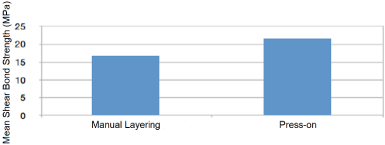
Figure 1: Mean values of micro-shear bond strength of veneering technique
(Hafez).
All specimen, which were prepared by manual veneering, showed adhesive failure. This might originate from the multitude of air bubbles observed in the veneering.
Specimens veneered by press–on technique showed cohesive failures, with a dense, bubble-free, and homogeneous surface. Hafez et al. [52] attribute this failure behavior and the high shear bond strength to mainly the controlled fabrication conditions. These result in less structural defects, improved wetting of the zirconia surface by the molten pressed ceramic, and reduced incorporation of air bubbles. Especially the reduced incorporation of air bubble is of high importance in terms of reliability, since air-bubbles have a highly negative effect on the mechanical strength of veneering ceramic itself and its bond strength to the underlying framework materials. Based on these advantages Hafez et al. [52] concluded that press–on veneering is a more reliable compared to manual layering.
Sim et al. [53] studied the shear bond strength between the veneering ceramic and zirconia. Layering, pressing and digital techniques to veneer the zirconia frameworks were employed in their investigations. A fusion powder was used to bond the CAD/ CAM prepared veneers to zirconia framework. The highest shear bond strength was obtained for CAD/CAM veneered zirconia frameworks (28.29 MPa). Lower shear bond strengths were obtained for the layering (18.65 MPa) and press-on (18.89 MPa) technique showing no significant difference between the press-on and layering technique. The CAD/CAM veneered specimens appeared to be more homogeneous, had lower porosity and the best interface bond strength. Therefore, CAD/CAM veneered specimens should provide better long-term stability in the intra-oral environment compared to those prepared by layering and heat press-on technique. Based on these results Sim et al. [53] consider the CAD/CAM veneering method to be more effective in clinical uses because the SBS is significantly higher than the ones obtained by the heat- press-on or layering.
Kim et al. [54] have investigated the influence of the layering technique and CAD/CAM technique on the Micro-Tensile Bond Strength (MTBS) at the zirconia core/veneer interface. The milled glass ceramic veneer was joined to the zirconia core using a fusion porcelain. The best results were achieved for the digital veneering technique with a MTBS of 37.8 MPa. The failure mode was 94% cohesive and 6% mixed (cohesive and adhesive). The layering technique provided a significantly lower MTBS, of 28.1 MPa. The failure mode changed to 78% cohesive and 22% mixed. The high MTBS obtained by the CAD/CAM veneering technique can be explained with fewer restoration defects. Using this technique, the specimens also had a reduced firing-shrinkage. According to Kim et al. [54], the CAD/CAM veneering technique appears to be better in terms of bond strength compared to the other investigated techniques.
Zaher et al. [55] applied the heat press-on and the CAD/CAM technique to study the influence of the veneering technique on the shear bond strength. The joint between CAD/CAM veneer and zirconia core was performed by a low fused ceramic. A high SBS was found for the CAD/CAM veneered specimens (41.2 ± 6.3 MPa) whereas for the heat-pressed ones, the SBS was only 21.3 ± 4.3 MPa. The failure mode was mostly adhesive at the ceramic interface for the both specimen groups. Nevertheless, larger parts of the veneer were still attached to the zirconia core for the specimens prepared by the CAD/CAM technique, whereas for the heat-press-on ones either none or only minor traces of veneer remained attached on the zirconia core. Based on these finding, Zaher et al. [55] concluded that the CAD/CAM veneering technique is advantageous when using low-fusing glass-ceramics as connector compared to the heat presson technique.
Merve et al. [57] investigated the shear bond strength between different CAD/CAM veneer materials and the zirconia framework proving a possible explanation for the reason chipping of zirconia restorations. They stated that many factors affect the stability of veneered zirconia frameworks. One of them is the weakness of the bond strength between the veneering material and framework. For their study, they have applied two veneering techniques: layering and CAD/CAM. IPS e.max CAD and Cerec Bloc were used for the CAD/CAM technique using resin cement or low fusing porcelain as connector. Also, the effect of the surface treatment was studied. Three surface treatments were applied for the resin cemented groups: no surface treatment, acid (4% HF) etching of the bonding interface of the veneer for 20 s, and HF acid etching of the bonding interface of the veneer in combination with the application of a glaze to the zirconia surface. The low fused ceramic was used as connector for CAD/CAM veneered group (Table 1).
Veneering procedure
Mean shear bond strength(MPa)
Vita, layering
24.23 ± 9.8
Cerec Bloc, resin cement, no surface treatment
15.29 ± 2.2
Cerec Bloc, resin cement, acid etched
18.47 ± 3.7
Cerec Bloc, resin cement, glaze layer
10.76 ± 2.5
Cerec Bloc, fusion porcelain
25.35 ± 5
IPS e.max CAD, resin cement, no surface treatment
9.82 ± 2.8
IPS e.max CAD, resin cement, acid etched
19.83 ± 6.6
IPS e.max CAD, resin cement, glaze layer
10.97 ± 5.9
IPS e.max CAD, fusion porcelain
27.11 ± 7.7
Table 1: Mean shear bond strength and standard deviation (MPa) (Merve).
Based on this study, the veneering technique and the surface treatments affected the bond strength between zirconia and resin cement, while the veneering materials had no effect. The CAD/CAM fused low ceramic veneering technique provided similar results compared to those with conventional layering (Table 1). Based on these results, the authors concluded that the fused CAD/CAM veneering technique can be an alternative to the conventional layering. They state there are certain advantages of the fused CAD/CAM veneering technique over the conventional. The first one is that handlingsteps, such as modeling, impression and finishing are completed by computer-controlled design and fabrication resulting in the desired shade, translucency, high homogeneity and a fast fabrication process. The second is that the fabrication of dental restorations does not need an experienced technician to minimalize defects during the preparation of the dental device. Kim and Kanat reported a higher bond strength for the CAD/CAM veneering technique compared to the layering one. According to Merve et al. [57] this difference can be explained by the different brand of zirconia, the veneering materials, the fusing ceramic, and different testing parameters. From this study, it can be concluded that the application of the glaze layer onto the zirconia surface does not improve the bond strength at the veneer / framework interface. The properties of resin cement and its ability to be chemically or physically bound at the interface play an important role in the stability of the dental restoration. This means that the bond strength at the resin/glaze interface affects the results.
Savas et al. [58] have investigated the effect of different surface treatments on the shear bond strength of lithium disilicate ceramics to the zirconia core. In their study, they have treated the zirconia surfaces as follows: no treatment (group C, control), sandblasted at a pressure of 3 bar for 10 s (group S), irradiated with Er-YAG laser (group E) and irradiated with a femtosecond laser pulses (group F). A low fused ceramic was used as a connector between the veneer and the framework (CAD-on, Ivoclar).
As can be seen from Table 2, the surface treatment of the zirconia core (sandblasting, Er.YAG laser, and femtosecond laser) does not affect the shear bond strength at the veneer/zirconia interface. Cohesive and adhesive failures have been observed for all testing groups. The occurrence of cohesive failures in all groups are a clear indication for a high SBS at the veneer/core interface. The authors explain the high shear bond strength in group F by the creation of regular pits which were filled with fused ceramic and act as micromechanical retention. In case of group E, the eroded zirconia surface can be responsible for the slightly lower SBS compared to group C. From this study, it can be concluded that the CAD-on technique does not need a surface treatment of the zirconia core for a good SBS.
Group
SBS
(MPa)
Control (C)
32.52 ± 10.15
Sandblasting with 50 μm
33.03 ± 5.05
Al2O3 particles (S)
Er:YAG laser irradiation (E)
31.02 ± 4.96
Femtosecond laser irradiation (F)
36 ± 3.31
Table 2: Mean shear bond strengths (SBS) (Savas).
Fracture strength
Turk et al. [49] have investigated the effect of veneering technique on the fracture strength of the zirconia framework. They applied the layering and press-on technique to veneer the zirconia framework. The load at fracture was determined by the first discontinuity in the load, whether it was an early cracking or a catastrophic failure.
Table 3 presents the results of the mean fracture loads for the layered veneering and the press-on veneering of the zirconia framework. The layered veneering shows slightly higher mean fracture loads 1884 N±190 N compared to the press-on veneering samples 1722 N±239 N (Table 3). Looking at the fractures, both adhesive as well as cohesive failure within the veneering ceramics was observed as depicted in Figure 2 and Table 4.
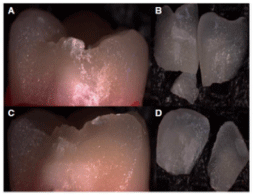
Figure 2: Stereomicroscope images of fractured zirconia frameworks,
(A) lingual view of pressed veneered zirconia and (B) fractured segments
(cohesive within ceramic), (C) lingual view of layered veneered zirconia and
(D) fractured parts (adhesive) (Turk).
Specimens
Fracture loads (N)
Layered veneered zirconia
1884 ± 190
core
Heat-pressed veneered zirconia core
1722 ± 239
Table 3: Mean fracture loads (N) (Turk).
Specimens
Adhesive
Cohesive within framework
Cohesive within ceramic (chipping)
Layered veneered zirconia
7
-
3
core
Heat-pressed veneered zirconia core
8
-
2
Table 4: Fracture types of zirconia frameworks (Turk).
The layered veneered specimens exhibited a small tendency to fail more often adhesively compared to the pressed-on ones (Table 4).
A fracture within the zirconia framework was never observed indicating that the veneering method does not negatively affect the mechanical properties of the zirconia core.
Turk et al. [49] attribute the fracture behavior with the veneering process itself. They state that during the heating and cooling cycles, the phase stabilization of zirconia can be affected. This may influence both the strength and the long-term behavior of this material. The low fractures forces observed for pressed-on specimens in comparison to layered ones explained by a higher pressing temperature of 910°C for the pressed-on ones compared to the processing temperature of the layering veneers (750°C). Due to the misfit in the coefficient of thermal expansion a higher mechanical stress can be build up at the interface at higher processing temperatures. The chipping of the veneer for zirconia restorations are explained with the defects in the veneering materials, incorrect cooling rates during the veneering processes, a weak bonding between the zirconia core and the veneer, and traumatic occlusion. The authors conclude in their study that the fracture loads of veneered zirconia cores are not affected by the used veneering technique if the same framework material is used.
Beuer et al. [43] used layering (VT), heat-pressing (PT), and CAD/CAM (ST) veneering technique to veneer zirconia frameworks. CAD/CAM framework and CAD/CAM veneer were connected by means of a low-fusing ceramic material.
A high fracture strength was obtained for the CAD/CAM veneered specimens compared to the layered and heat-pressed-on veneered specimens (Figure 3).

Figure 3: Fracture load of layered (VT), heat-pressed-on (PT), and CAD/
CAM (ST) veneering on zirconia frameworks (Beuer).
Two failure types were observed: total fracture, through both core and veneer and partial fracture through veneer only (chipping). In all instances of partial fracture, the fracture was cohesive within the veneer (Figure 4).

Figure 4: Cohesive fracture of a specimen from layering technique (Beuer).
One of the factors responsible for the failure of dental ceramic restorations is the surface tension, which results in slow propagation of cracks and flaws. In all-ceramic systems the flaw population (size, number, and distribution) depends on the material itself and on its fabrication process. It is predicted that the heat-pressing process introduces fewer flaws than the layering process, resulting in higher strength properties, because the fabrication process is a more controlled procedure. The layering technique is more sensitive and subject to the skill of the dental technician and the firing procedures. However, the results of Beuer et al. [43] do not confirm this hypothesis. They found no statistical difference between layered and heat-pressed-on veneered specimens. The authors explain their results with the homogeneity and the distribution of flaws which seem to be similar for both specimen groups. The failure modes are inconclusive and exhibit both, cohesive and adhesive. The cohesive failure mode observed for the layering technique is explained by the good interfacial bond between the framework and veneering material, which is crucial for the success of the dental restorations.
These authors state that the CAD/CAM veneering technique leads to an extremely cost-effective fabrication of all-ceramic veneered crowns merely using established CAD/CAM facilities for the production of the two parts, which have to be joined by only one firing procedure (Beuer 2009).
Schmitter et al. [44] investigated the ultimate load to failure of zirconia-based crowns veneered with CAD/CAM manufactured ceramic. This study aims to find the origin of the chipping phenomena of zirconia restorations. Dental zirconia has excellent properties in comparison to metal restorations due to its high fractural and toughness strength, biocompatibility, its aesthetic appearance. In comparison to metal-ceramic restorations, zirconia restorations suffer from adhesive (delamination) and cohesive (chipping) failures. When the failure of veneer affects the functional or aesthetical area, a repeated restoration is mandatory which is time-consuming for dental labor, and the worse-case for both dentist and patient (Schmitter).
CAD/CAM-veneering and layered-veneering techniques were used.
The joint between the CAD/CAM manufactured veneer and the framework was made using the low fusing ceramic (Figure 5).
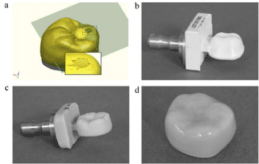
Figure 5: a) modified cups surface with defined inclination (30° with respect
to direction of insertion) and spherical depression at the load application
point, b) milled frame, c) milled veneer, d) complete crown (Schmitter).
These authors also investigated the influence of artificial ageing on the critical load responsible for the adhesive failure at the framework/ veneer interface and/or the cohesive failure within the veneer ceramics. The ageing process consisting of 10 000 thermocycles. They demonstrated that the crowns made of zirconia frameworks veneered with CAD/CAM manufactured lithium disilicate ceramics display a higher fracture strength resistance compared to manually veneered crowns (Figure 6a). CAD/CAM veneered crown seem not to be affected by the artificial ageing, whereas almost all manually layered crowns failed during chewing test (Figure 6b). In order to reduce the frequency of adhesive and cohesive failures for zirconia frameworks in the case of layering technique, a lot of works has been done. This includes optimizing of firing protocol, the framework design, the fabrication process, the use of pressed ceramics etc.
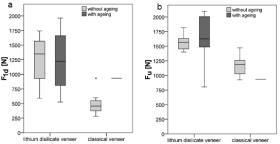
Figure 6: Results for crowns ‘survival rate during chewing stimulation. a) load
at first tdamage of veneers, b) ultimate load (Schmitter).
Another possibility is the application of CAD/CAM technology for the production of framework and veneer. These authors concluded that the CAD/CAM production of veneering restorations with zirconia frameworks is a promising way to reduce failures. Schmitter et al. [44] also suggest that optimizing of firing protocol can improve the fatigue behavior and fracture strength of handlayered veneered zirconia framework. According to these authors, the veneering material also plays an important role on the quality of zirconia restoration.
In the other work Schmitter and al. [56] have investigated the effect of the attachment technique on the fracture strength of the zirconia framework. Zirconia frameworks and veneers were milled by CAD/CAM technique. The attachment of the veneers onto the zirconia was carried out by two methods:
1. Multilinik implant
First, the veneering layer was etched with 5% hydrofluoric acid for 20 s, after that Monobond Plus was applied to the sandblasted zirconia framework to attach the veneer.
2. The CAD-on technique was used for the second group.
The effect of aging on the fracture strength of zirconia frameworks was investigated for both groups.
The fracture strength was measured according to the Figure 7.
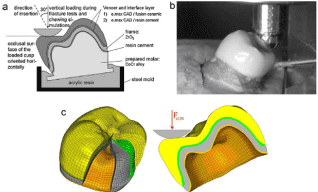
Figure 7: Schematic diagram of the mechanical test. The load was applied to
the mesio-lingual cups at an angle of 30° to the insertion direction. (b) in vitro
test setup. (c) Finite element model of the tested crowns (Schmitter).
As can be seen from (Figure 8) and (Table 5) better results were obtained for CAD-on groups.
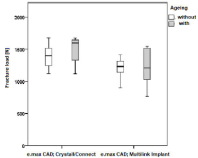
Figure 8: Whisker and box plots of fracture loads with and without artificial
aging (Schmittler).
group
without aging
after aging
CAD-on
1388 ± 190 N
1492 ± 206 N
resin cemented veneer
1211 ± 158 N
1226 ± 290 N
Table 5: Mean fractural loads of zirconia frameworks veneered by two different veneering techniques (Schmitter).
Table 5 show that the aging process significantly affects the fracture strength of the CAD-on group, while it has hardly an impact on the resin cemented veneer.
All crowns survived the chewing stimulation which means the bonding at CAD/CAM milled veneer / zirconia interface is insensitive to the aging processes.
Adhesive failures of the veneer were predominant in both groups with a smaller delamination area for CAD-on group. It can be concluded that the bond strength at luting resin / framework and luting resin/veneer interfaces control the failure modes of the luting group, because the veneer has no direct contact to the framework. For the CAD-on group, other factors, such as the homogeneity of the contact layer, the CTE, the bond strength at veneer / framework interface etc. have an impact on the failure modes [56].
For high fractures loads, a damage of the margin of zirconia framework was observed for the CAD-on group, while the luting group was not affected (Figure 9).
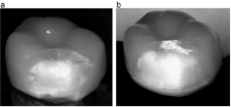
Figure 9: Fracture modes of (a) CAD-on and (b) resin cement groups
(Schmitter).
This behavior can be explained by the tensile stresses within the veneer and at the interfaces, which are created by the firing process of the CAD-on group. During the firing process, two hard interfaces, veneer/fused ceramic and fused ceramic/frame, generate tensile stresses within the veneer and the interface layer that lead to a fracture of the veneer under high fracture loads. In the case of the luting group, the hard interface is missing and the soft resin at the interface reduces tensile stresses. The chemical and physical properties of luting cements are important factors for the clinical success of dental restorations [27]. The ability to promote a stable and strong joint between the restorative materials, a high resistance to delamination, a suitable Young’s modulus, biocompatibility etc. are the properties which must be considered for the luting technique. This technique requires a surface treatment of framework, which can influence the fracture resistance of the framework. Although omitting this factor in their discussion, the authors concluded that both techniques can be used in a clinical setting. They recommend luting of veneer because it is much easier and could be performed chair-side in the dental practice, and the CAD-on technique for its higher fracture resistance.
Kanat et al. [60] have investigated the effect of different veneering procedures (layering, over-pressing, and CAD-on) on the Fracture Resistance (FR) of single molar crown restorations with zirconia framework. They have investigated also the effect of the Flexural Strength (FS) of the veneering ceramic on the FR of the restoration, the effect of interfacial bonding on the FR by a Shear Bond Strength test (SBS).
A lower fracture resistance was obtained for over-pressed veneered specimens (see Table 6), whereas the layered and CAD-on veneered specimens do not show large FR differences.
Veneered Specimens
Fracture resistance (FR)
(N)
Flexural strength (FS)
(MPa)
Shear bond strength (SBS)
(MPa)
Over-pressed
2507 ± 594
566 ± 54
30 ± 8
layered
4323 ± 462
428 ± 41
28 ± 5
CAD-on
4408 ± 608
583 ± 63
49 ± 6
Table 6: Fracture loads, flexural strength and shear bond strength of differently veneered specimens (Kanat).
The authors explained the high FR of the layered veneered groups by the anatomical framework design. Layered veneered specimens exhibit a low flexural strength, whereas the other two veneering groups showed almost the same FS. A high SBS was obtained for CAD-on veneered specimens, the SBS of the other two veneering groups are drastically lower than the CAD-on ones, but very similar compared to each other (Table 6). No signs of imperfections within the ceramic or along the interfacial area are detected for the CADon veneered specimens, whereas many lateral cracks and porosities are observed for the other specimen groups. Porosity and partial detachment of veneers along the zirconia/veneer interface is observed for the layered and over-pressed specimens.
One of the factors for the lack of porosity or other imperfection in CAD-on veneered specimens is the homogeneity of the ceramic block. Lateral cracks and porosities observed for layered and over-pressed veneered specimens can be explained by the sensitivity of these veneering techniques. According to Kanat et al. [60], the veneering technique, the properties of the veneering materials, the interfacial bonding, and the anatomical framework design play a crucial role for the stability of the dental restoration. They concluded that the CAD-on technique could decrease ceramic chipping due to a higher strength of the ceramic and interfacial bonding. The anatomical framework design can further improve the fracture resistance if the layering technique is applied.
Tangasatchatham et al. [61] have investigated the effect of CAD/ CAM veneering ceramics and different bonding techniques on the flexural strength of zirconia cores.
As CAD/CAM veneering ceramics they have used feldspathic Vita blocks (Vm), IPS e.max CAD (Em), Vita Suprinity (Vs) and Celtra Duo (Cd). Two methods were employed to apply the veneer to the zirconia cores: CAD-bonding (Cb) and CAD-fusing (Cf).
This study indicates that the flexural strength of zirconia core strongly depends on the veneering ceramic and techniques. A high flexural strength was obtained for Celtra Duo (Cf) 953.12 ± 134.30 MPa, (Figure 10 & Table 7).
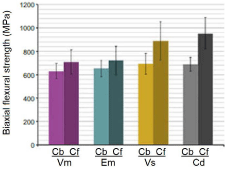
Figure 10: The effect of veneering ceramic types on the fracture strength
(Tangsatchatham).
Group
Flexural strength
(MPa)
Vm (Cb)
630 ± 65.08
Vm (Cf)
709 ± 102.88
Em (Cb)
651 ± 69.48
Em (Cf)
721 ±121.28
Vs (Cb)
692.83 ± 89.10
Vs (Cf)
888.61 ± 164.26
Cd (Cb)
687.17 ± 59.39
Cd (Cf)
953.12 ± 134.30
Table 7: The mean flexural strength of veneered zirconia cores (Tangsatchatham).
The authors explain the high flexural strength obtained for Cd and Vs veneers only by the high flexural strength of these veneers (~ 420 MPa). Em and Vm have a flexural strength of 360 MPa – 400 MPa and 154 MPa, respectively. There are different factors, which affect the flexural strength of the zirconia core: the CTE mismatch between veneer and core, the bond strength at the veneer/core interface, the tetragonal to monoclinic phase transformation of the zirconia core because of sandblasting or firing (Hallmann) [63-66], the cracks created during sandblasting/ firing processes etc. In the case of the Cb technique, the CTE mismatch between veneer and zirconia does not affect the flexural strength of the core because a resin cement separates the two materials. In the case of the Cf technique, additional factors affect the flexural strength of the core: the wettability of the fused ceramic on the zirconia core, the homogeneity of the interfacial layer, the bonding strength at the veneer/core interface, and the firing process etc. From the results of this study, it can be concluded that the CAD-fused technique, could achieve a better clinical outcome, because it provides a higher flexural strength than the Cb-bonded technique,
Future
A new method is developed to produce CAD/CAM blanks, which can be applied for all veneer’s kinds. The blanks are multilayers and can be used to veneer zirconia or metal frameworks (Figure 11).
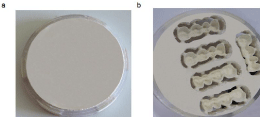
Figure 11: CAD/CAM veneers blanks, a) before and b) after milling.
CAD/CAM banks are typically produced by using the slurry method: water as solvent, and polymers (dispersant, bonder, plasticizer and anti-foamier). After milling the joint between zirconia or metal core and the CAD/CAM veneer is performed using the same ceramic powder of the blanks or a low fused ceramic powder. The connector is not supplied in the form of a separate paste. The dental technicians must mix the ceramic powder with the same liquid as in the production of CAD/CAM blanks. The paste is applied to the surface of the framework by a brush. The properties of these blanks are currently under investigation by Hallmann et al. [62]. The multilayered CAD/CAM veneering blanks simplify the work of dental technicians, since many work steps are reduced, the efficiency of the dental laboratory is increased and the veneering of frameworks does not require technicians who master the handling of ceramics perfectly.
Conclusion
The stability of a ceramic restoration depends on many factors such as the type of bonds (chemical or physical), flaws, cracks and their propagation. The choice of the veneering fabrication technique has a great influence on the mechanical stability of the ceramic restoration. The CAD/CAM engineering technique seems to improve the stability of restorations due to the simplicity and therefore high reproducibility of the fabrication process. Many steps required to prepare dental restorations are avoided, and firing/cooling cycles are shortened (one firing cycle), which in turn increase the efficiency of the application in clinical practice. The CAD-veneering technique avoids the negative influences of human error offering higher precision and reduced cost.
CAD/CAM technology for the preparation of dental restorations have increased the productivity of dental laboratories tremendously and changing them to modern digital production centers. In the future, the CAD/CAM technology will replace more and more the currently widely-used convectional techniques in restorative dentistry.
References
- Miyazaki T, otta Y, Kuni J, Kuriyama S, Tawaki Y. A review of dental CAD/ CAM. Current status and future perspectives from 20 years of experience. Dent Mater. 2009; 28: 44-56.
- Miyazaki T, Hotta Y. CAD/CAM systems available for the fabrication of crown and bridge restoration. J Australian Dent. 2011; 56: 97-106.
- Miyazaki T, Nakamura T, Matsumura H, Ban S, Kobayashi T. Current status of zirconia restoration. J Prosthodont Res. 2013; 57: 236-261.
- Samra APB, Morals E, Mazur RF, Vieira SR, Rached RN. CAD/CAM in dentistry-a critical review. Rev Odonto Cienc. 2016; 31: 140-144.
- Rekow ED, Silva NRFA, Coelho P, Thang Y, Guess P, Thompson VP. Performance of dental ceramics: challenges for improvements. J Dent Res. 2011; 90: 937-952.
- Noort R. The future of dental devices is digital. J Dent Mater. 2012; 28: 3-12.
- Beuer F, Schweiger J, Edelhoff D. Digital dentistry: an overview of recent developments for CAD/CAM generated restorations. J British Dent. 2008; 204: 505-511.
- Chaar MS, Passia N, Kern M. Ten-year clinical outcome of three-unit posterior FDPs made from a glass-infiltrated zirconia reinforced alumina ceramic (In- Ceram Zirconia). J Dentistry. 2015; 43: 512-517.
- Teichmann M, Wienert AL, Rückbell M, Weber V, Wolfart S, Edelhoff D. Tenyear survival and chipping rates and clinical quality grading of zirconia-based fixed dental prostheses. Clin Oral Invest. 2018; 22: 2905-2915.
- Silva LH, Miranda RB, Favero SS, Lohbauer U, Cesar PF. Dental ceramics: a review of new materials and processing methods. Braz Oral res. 2017; 31: 132-146.
- Denry I, Kelly JR. State of the art of zirconia for dental applications. Dent Mater. 2008; 24: 299-307.
- Denry I, Holloway JA. Ceramics for dental applications: A Review. J Mater. 2010; 3: 351-368.
- Denry I, Kelly JR. Emerging ceramic-based materials for dentistry. J Dent Res. 2014: 93: 1235-12424.
- Kelly JR. Dental ceramics: current thinking and trends. Dent Clin North Am. 2004; 48: 513-530.
- Kelly JR, Benetti P. Ceramic materials in dentistry: historical evolution and current practice. J Australian Dent. 2011; 56: 84-96.
- Chevalier J. What future for zirconia as a biomaterial? Biomater. 2006; 27: 535-543.
- McLaren EA, Cao PT. Ceramics in Dentistry-Part 1: Classes of Materials. Inside Dentistry. 2009; 5: 94-105.
- Abdullah AO, Muhammed FK, Zheng B, Liu Y. An overview of computer aided design/computer aided manufacturing (CAD/CAM) 9n restorative dentistry. J dent Mater Tech. 2018; 7: 1-10.
- Abduo J. Fit of CAD/CAM implant frameworks: A comprehensive Review. J Oral Implantol. 2014; 40: 758-766.
- Kim RW, Chow TW, Matinlinna JP. Ceramic dental biomaterials and CAD/ CAM technology: State of the art. J Prosthodont Res. 2014; 58: 208-216.
- Belli R, Petschelt A, Hofner B, Hajto J, Scherrer SS, Lohbauer U. Fracture rates and lifetime estimations of CAD/CAM all-ceramic restorations. J Dent res. 2016; 95: 67-73.
- Chavali R, Nejat AH, Lawson NC. Machinability of CAD-CAM materials. J Prosthet Dent. 2017; 118: 194-199.
- Goujat A, Abouelleil H. Colon P, Jeannin C, Pradelle N, Seux D, Grosgogeat B. Mechanical properties and internal fit of 4 CAD_CAM block materials. J Prosthet Dent. 2018; 119: 384-389.
- Preis V, Hahnel S, Behr M, Rosentritt M. In vitro performance and fracture resistance of novel CAD/CAM ceramic molar crowns loaded on implantans and human teeth. J Adv Prosthodont. 2018; 10: 300-307.
- Zimmermann M, Koller C, Mehl A, Hickel R. Indirect zirconia-reinforced lithium silicate ceramic CAD/CAM restorations: Preliminary clinical results after 12 months. Quintessence Int. 2017; 48: 19-25.
- Lambert H, Durand JC, Jacquot B, Fages M. Dental biomaterials for chairside CAD/CAM: state of the art. J Adv Prosthodont. 2017; 9: 486-495.
- Pini NP, Aguiar FHB, Lima DANL, Lovadino JR, Terada RSS, Pascotto RC. Advances in dental veneers: materials, applications, and techniques. Clinical, Cosmetic and Investigational Dent. 2012; 4: 9-16.
- Hallmann L, Ulmer P, Kern M. Effect of microstructure on the mechanical properties of lithium dislicate glass-ceramic. J Mecha Behav Biomed Mater. 2018; 82: 355-370.
- Hallmann L, Ulmer P, Gerngroβ MD, Jetter J, Mintrone M, Lehmann F, et al. Properties of hot-pressed lithium silicate glass-ceramics. Dent Mater. 2019; 35: 713-729.
- Turk AG, Uluso M, Yuce M, Akin H. Effect ofdifferent veneering technique on the fracture strength of metal and zirconia framework. J Adv Prosthodont. 2015; 7: 454-459.
- Passia N, Chaar MS, Kern M. Outcome of posterior fixed dental protheses made from veneered zirconia over an observation of up to 13 years. J Dent. 2019; 86: 126-129.
- Sailer I, Pjetursson BE, Zwahlen M, Hämmerle CH. A systematic review of the survival and complication rate of all-ceramic and metal-ceramic reconstructions after an observation period of at least 3 years. Part II: Fixed dental protheses. Clin Oral Implants res. 2007; 18: 86-96.
- Sailer I, Balmer M, Husler J, Hämmerle CHF, Kanel S, Thoma DS. Comparison of fixed dental protheses with zirconia and metal frameworks: five-year results of a randomized controlled clinical trial. J Prosthodont. 2017; 30: 426-428.
- Sailer I, Strasding M, Valente NA, Zwahlen M, Liu S, Pjetursson BE. A systematic review of the survival and complication rates of zirconia-ceramic and metal-ceramic multiple-unit fixed dental protheses. Clin Oral Impl res. 2018: 29: 184-198.
- Sailer I, Balmer M, Hüsler J, Hämmerle CHF, Känel s, Thoma DS. 10-year randomized trial (RCT) of zirconia-ceramic and metal-ceramic fixed dental protheses. J Dent. 2018; 76: 32-39.
- Pjetursson B, Valente NA, Strasding M, Zwahlen M, Sailer I. A systematic review of the survival and complication rates of zirconia-ceramic and metallic single crowns. Clin Oral Impl Res. 2018; 29: 199-214.
- Ruiz MFS, Panadero RA, Font AF, Rueda CL. A prospective evaluation of zirconia anterior partial fixed dental prostheses: Clinical results after seven years. J Prosthet Dent. 2015; 113: 578-584.
- Raigrodski A.J. Contemporary materials and technologies for all-ceramix fixed partial dentures: A review of the literature. J Prosthet Dent. 2004; 92: 557-562.
- Raigrodski AJ, Hillstead MB, Meng GK, Chung KH. Survival and complications of zirconia-based fixed dental prostheses: A systematic review. Int J Prosthodont. 2012; 25: 21-23.
- Pihlaja J, Näpänkangas R, Raustia A. Outcome of zirconia partial fixed dental prostheses made by predoctoral dental students: a clinical retrospective study after 3 to 7 years of clinical service. J Prosthet Dent. 2016; 16: 40-46.
- Bidra AS, Tischler M, Patch C. Survival of 2039 complete arch fixed implantsupported zirconia prostheses: A retrospective study. J Prosthet Dent. 2017.
- Komine F, Strub JR, Matsumura H. Bonding between layering materials and zirconia frameworks. J Dent Sci. 2012; 48: 153-161.
- Beuer F, Schweiger J, Eichberger M, Kappert HF, Gernet W, Edelhoff D. High-strength CAD/CAM-fabricated veneering material sintered to zirconia copings A new fabrication mode for all-ceramic restorations. Dent Mater. 2009; 25: 121-128.
- Schmitter M, Mueller D, Rues S. Chipping behavior of all-ceramic crowns with zirconia framework and CAD/CAM manufactured veneer. J Dent. 2012; 40: 154-162.
- Quinn JB, Sundar V, Parry EE, Quinn GD. Comparison of edge chipping resitance of PME and veneered zirconia specimens. Dent Mater. 2010; 26: 13-20.
- Koenig V, Vanheusden AJ, Le Goff SO, Mainjot AK. Clinical risk factors related to failures with zirconia-based restorations: An up to 9-year retrospective study. Dent. 2013; 41: 1164-1174.
- Oilo M, Kvam K, Gjerdet NR. Load at fracture of monolithic and bilayered zirconia crowns with and without a cervical zirconia collar. J Prosth Dent. 2016; 115: 630-636.
- Panadero RA, Rodriguez JLR, Ferreiroa A, Ruiz MFS, Font AF. Zirconia in fixed prosthesis. A literatur review. J Clin Exp Dent. 2014; 6: e66-e73.
- Turk AG, Uluso M, Yuce M, Akin H. Effect ofdifferent veneering technique on the fracture strength of metal and zirconia framework. J Adv Prosthodont. 2015; 7: 454-459.
- Bömicke W, Rammerlberg P, Stöble T, Schmittler M. Short-term prospective clinical evaluation of monolithic and partially veneered zirconia single crowns. J Esthet Restor dent. 2017; 29: 22-30.
- Hung CY, Huang YS. Effect of veneering techniques on ceramic fracture of zirconia restoration. J Prosthodont and Implant. 2012; 1: 66-70.
- Hafez MA, Bourauel C, Aboushelib MN, Ragy NH. Bonding of veneering porcelain to zirconia based ceramics using a novel surface treatment method. IJSRM Human. 2017; 8: 149-164.
- Sim JY, Lee WS, Kim JH, Kim H, Kim WC. Evaluation of shear bond strength of veneering ceramics and zirconia fabricated b digital veneering method. J Prosthodont Res. 2016; 60: 106-113.
- Kim KY, Kwon TK, Kang TJ, Yang JH, Lee SJ, Yeo IS. Digital veneering system enhances microtensile bond strength at zirconia core-veneer interface. J Dent Mater. 2014; 33: 792-798.
- Zaher AM, Hochstedler JL, Rueggeberg FA, Kee EL. Shear bond strength of zirconia-based ceramics veneered with 2 different techniques. J Prothet dent. 2017; 118: 2221-227.
- Schmitter M, Schweiger M, Müller D, Rues S. Effect of in vitro fracture resistance of the technique used to attach lithium disilicate ceramic veneer to zirconia frameworks. Dent Mater. 2014; 30: 122-130.
- Tanis MÇ, Kiliçarslan MA, Bellaz IB. In vitro evaluation of bond strength between zirconia core and CAD/CAM-produced veneers. ACP Prosthodont. 2019; 1-6.
- Savas TY, demir N, Ozturk N, Kilic H. Effect of different surface treatment on the bond strength of lithium disilicate ceramic to the zirconia core. Photomed and Laser Surgery. 2016; 34: 236-243.
- IPS+e-max+CAD+Veneering+Solution.pdf.
- Kanat B, Cömlekoglu EM, Cömlekoglu MN, Sen BH, özcan M, Güngör MA. Effect of various veneering technique on mechanical strength of computeres controlled zirconia framework designs. J Am Prosthodont. 2014; 00: 1-11.
- Tangsatchatham S, Juntavee N. Flexural strength of various types of computerized machinable ceramic veneered to yttria stabilized tetragonal zirconia polycrystalline ceramic upon different hybridized techniques. Clinical, Cosmetic and Investigational Dentistry. 2019; 11: 61-71.
- Hallmann L, M-D Gerngroβ. Production of CAD/CAM veneer blanks and their properties (in preparation).
- Hallmann L, Ulmer P, Wille S, Kern M. Effect of differences in coefficient of thermal expansion of veneer and Y-TZP ceramics on the interface phase transformation. J Prosdent. 2014; 112: 591-599.
- Hallmann L, Ulmer P, Reusser E, Hämmerle CHF. Surface characterization of dental Y-TZP ceramic after air abrasion treatment. J Dent. 2012; 40: 723- 735.
- Hallmann L, Ulmer P, Reusser E, Hämmerle CHF. Effect of blasting pressure, abrasive size and grade on phase transformation and morphological change of dental zirconia surface. Surf & Coat Technol. 2012; 206: 4293-4302.
- Hallmann L, Mehl A, Ulmer P, Reusser E, Stadler J, Zenobi R, et al. The influence of grain size on low-temperature degradation of dental zirconia. J Biomed Mater Res Part B. 2012: 100B: 447-456.